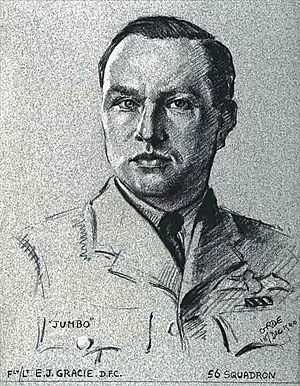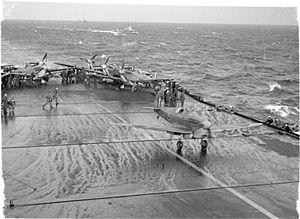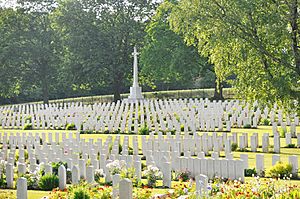Edward Gracie facts for kids
Quick facts for kids
Edward Gracie
|
|
|---|---|

Portrait of Gracie, made by Cuthbert Orde in December 1940
|
|
| Nickname(s) | Jumbo |
| Born | 21 September 1911 Acton, London, United Kingdom |
| Died | 15 February 1944 (aged 32) Hanover, Germany |
| Buried |
Hanover War Cemetery, Germany
|
| Allegiance | United Kingdom |
| Service/ |
Royal Air Force |
| Rank | Wing Commander |
| Commands held | No. 23 Squadron No. 601 Squadron No. 126 Squadron Takali Fighter Wing No. 169 Squadron |
| Battles/wars | Second World War |
| Awards | Distinguished Flying Cross Mention in Despatches |
Edward Gracie (born September 21, 1911 – died February 15, 1944) was a brave British pilot. He was known as a flying ace during the Second World War. This means he shot down at least five enemy aircraft. Gracie served with the Royal Air Force (RAF). He was officially credited with shooting down seven enemy planes.
Gracie was born in Acton, London. He joined the RAF in 1930. After a few years, he left the service. He rejoined as an officer in the reserve in 1937. When World War II began, he was called back to duty. He flew in the Battle of France in May 1940. Later, he fought in the Battle of Britain. During this time, he achieved his first victories in the air. He was injured at the end of August 1940.
He received the Distinguished Flying Cross (DFC) later that year. In 1941, he led two different squadrons: No. 23 Squadron and No. 601 Squadron. Gracie was sent to Malta in early 1942. He helped defend the island during heavy bombing. He commanded No. 126 Squadron there. After leading the Takali Fighter Wing, he returned to the UK. He commanded No. 169 Squadron from October 1943. He was killed in action over Hanover, Germany, on February 15, 1944.
Contents
Early Life and Joining the RAF
Edward John Gracie was born on September 21, 1911. His parents were Donald Michael and Mary Elizabeth Gracie. He grew up in Acton, London, a suburb of London. In June 1930, Edward joined the Royal Air Force (RAF). He served for three years.
He left the RAF in 1933. After that, he worked in sales. In 1935, he married Patricia Mary Cawley. In March 1937, he joined the Reserve of Air Force Officers. This meant he could be called back to serve if needed. When the Second World War started, he was called up for duty.
Fighting in the Second World War
In early 1940, Gracie was sent to No. 79 Squadron. He was known by his nickname, 'Jumbo'. On March 20, he was promoted to flight lieutenant. His squadron flew Hawker Hurricane fighters. They were based at Manston. Their job was to protect London from air attacks.
In May, his squadron went to France. They helped other RAF fighter squadrons. This was during the German invasion of France. They fought for only ten days. Then, they returned to the United Kingdom.
Battle of Britain Heroics
In June 1940, Gracie joined No. 56 Squadron. He became one of its flight commanders. His squadron flew Hurricanes. They often escorted Bristol Blenheim light bombers. These bombers attacked targets in France.
Soon, the Luftwaffe (German Air Force) attacked England more often. So, Gracie's squadron started intercepting enemy planes. They became very busy in the Battle of Britain. On July 10, Gracie shot down a Messerschmitt Bf 110 heavy fighter. This was near Ramsgate. It was his first victory in the air. Five days later, he likely destroyed a Dornier Do 17 medium bomber near Harwich.
On July 20, Gracie and two other pilots worked together. They destroyed a Junkers Ju 88 medium bomber. This happened southwest of Clacton. Five days later, he shot down a Junkers Ju 87 dive bomber near Dover. On August 13, he damaged two Messerschmitt Bf 109 fighters. This was over Rochford. Three days later, he probably destroyed another Bf 109. This was near Eastchurch.
On August 18, he shot down a Bf 110 east of Bradwell. On August 27, he helped destroy a Do 17 near Cap Gris-Nez. The next day, he shot down another Do 17. This was east of Southend. His last victories in the Battle of Britain were on August 30. He destroyed one Heinkel He 111 medium bomber. He also damaged a second one. Both were north of his squadron's base at North Weald. His own Hurricane was damaged in this fight. He had to make an emergency landing near Halstead. He was thought to be fine at first. But doctors found he had broken his neck. He was then sent to the hospital.
For his bravery, Gracie received the Distinguished Flying Cross (DFC). This award is given for courage in air combat. The official announcement said:
This officer has destroyed seven enemy aircraft and damaged another five. By his outstanding leadership, skill and courage, he has proved an excellent example to all.
Gracie returned to No. 56 Squadron a week after getting his DFC. The fighting was quieter in his area then. In December, Gracie was promoted to squadron leader. This was a temporary rank.
Leading Squadrons
In March 1942, Gracie became commander of No. 23 Squadron. This squadron flew Blenheims as night fighters. They were going to get new Douglas A-20 Havoc night intruder planes. On March 14, he flew a mission to Merville in France. He probably destroyed a Do 17.
His time as commander was short. The next month, he took command of No. 601 Squadron. This new unit flew Hurricanes. They took part in the Circus offensive. These were missions over German-occupied Europe. In August, the squadron moved to Duxford. They started using the Bell P-39 Airacobra fighter. This American plane was not very successful for the RAF. No. 601 Squadron was the only RAF unit to use it. It had many accidents. Gracie's time leading the squadron ended in December 1941.
Defending Malta
In early 1942, Gracie was sent to Malta. He sailed on the aircraft carrier HMS Eagle. On March 21, he flew a Supermarine Spitfire fighter off its deck. He landed safely at Takali airfield on Malta. Eight other pilots also arrived with him. These Spitfires were meant for a new No. 126 Squadron. Gracie was to be its commander. But Malta had lost many Spitfires already. So, some new planes went to No. 249 Squadron.
On March 26, Gracie led five Spitfires. They damaged a Ju 88 over the island. But his own plane was hit and damaged. On April 2, he probably destroyed a Ju 88. Later that month, he went to Gibraltar. He boarded the aircraft carrier USS Wasp. This was for Operation Calendar. The goal was to bring more Spitfires to Malta. Gracie helped guide them. On April 20, he flew the first of 47 Spitfires off Wasp. He led them safely to Malta.
The next day, the Luftwaffe launched a huge raid on Malta. Gracie flew to intercept Ju 88s. He destroyed two of them. He saw them crash into the sea north of Malta. Later that day, he was called to fight more Ju 88s. He damaged two and probably destroyed another. Two days later, he had his last aerial victory. He shared in shooting down a Ju 87. This happened over the dockyard at Valetta. At the end of April, Gracie was promoted to acting wing commander. He was made leader of the Takali fighter wing.
One of Gracie's first jobs as wing leader was to prepare Takali Airfield. It needed to be ready for more Spitfires. These arrived on May 9 in Operation Bowery. The new Spitfires had to be refueled and rearmed quickly. This was to avoid German bombing raids. Within minutes of landing, they were back in the air. Gracie flew one of them. Planes were very important. Gracie even threatened to move a pilot who crashed his Spitfire. He finished his service on Malta at the end of July. He was highly respected by his pilots. The famous Canadian flying ace George Beurling called him "Mr Malta."
Later War Service and Final Mission
After a break, Gracie commanded No. 32 Squadron in September 1942. This squadron was training for an overseas mission. Then, he spent several months as an instructor. He taught at No. 57 Operational Training Unit at Hawarden.
In October 1943, Gracie was given command of the new No. 169 Squadron. This squadron was based at Ayr. They flew de Havilland Mosquito heavy fighters. The squadron joined Bomber Command's No. 100 Group. Their job was to support bombing missions into German-occupied Europe. After training, they became active in January 1944. Gracie flew on their first mission to Hamburg.
On February 15, 1944, Gracie flew a mission over Hanover, Germany. His Mosquito plane was attacked by a German night fighter. His navigator managed to parachute out safely. But Gracie was killed. He was honored after his death on June 8, 1944. He is buried at the Hanover War Cemetery.
By the time he died, Gracie was credited with shooting down seven German aircraft. He also shared in shooting down three others. He probably destroyed five aircraft and damaged six more.



